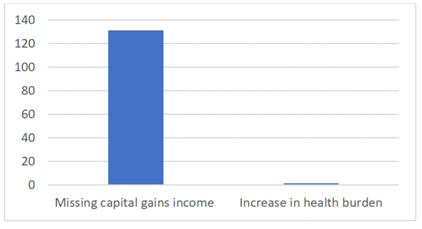Key Findings:
- Last year Australian GDP was $2 trillion but Australian households received another $1.7 trillion in capital gains as wealth increased to $12.7 trillion. The IGR compares government spending with GDP but misses the capital gains which boost capacity to pay and are heavily biased towards the rich who can afford to pay.
- The big picture in Australia is that wealth has increased massively, increasing from 3.6 times GDP 30 years ago, to 6.4 times GDP now. Moreover, wealth and capital gains will continue their upward trajectory and in 40 years’ time are likely to swamp GDP even more.
- The intergenerational report is supposed to question whether Australia can afford the spending associated with the aging of the Australian population. However, the IGR compares spending pressures with GDP alone.

(both expressed as a proportion of GDP)
- By 2060, the Federal Government’s self-imposed cap of 23.9 per cent of GDP might be as low as 10.4 per cent of a comprehensive measure of income that includes capital gains.
- And the distribution of income will worsen. Wealth is distributed much more unevenly than conventional measures of income so that as wealth increases, capital gains increase and they pull the total income distribution further apart.
“The vast majority of wealth in Australia is held in the hands of those aged over 55. In the coming decades, not only is the wealth of Australians likely to grow rapidly but that wealth will almost certainly flow primarily to those aged over 55,” said David Richardson, senior research fellow at the Australia Institute.
“Rapid increases in wealth, like the one Australia has already experienced and the one we will likely experience in the decade ahead, are a good problem to have. But unless we reform our tax system, the benefits of growing wealth will come with significant costs in the form of inequality and economic inefficiency.
“Because Australia currently has no taxes on wealth, and collects very little income from capital gains, government revenues have not grown nearly as rapidly as the wealth of Australians. The Australian Government may keep choosing not to tax wealth and capital gains of our wealthiest people as thoroughly as it taxes the incomes of ordinary workers. However, such choices make it hard to argue that Australia ‘can’t afford’ to provide healthcare in the years to come to what will clearly be the wealthiest generation Australia has ever known.
“It’s remarkable that in the five intergenerational reports produced by the Australian Treasury, not one of them has examined the rate of growth or the distribution of wealth in Australia. How can you ask about intergenerational equity without considering wealth and the way it is, or isn’t taxed?”
Source: Australia Institute